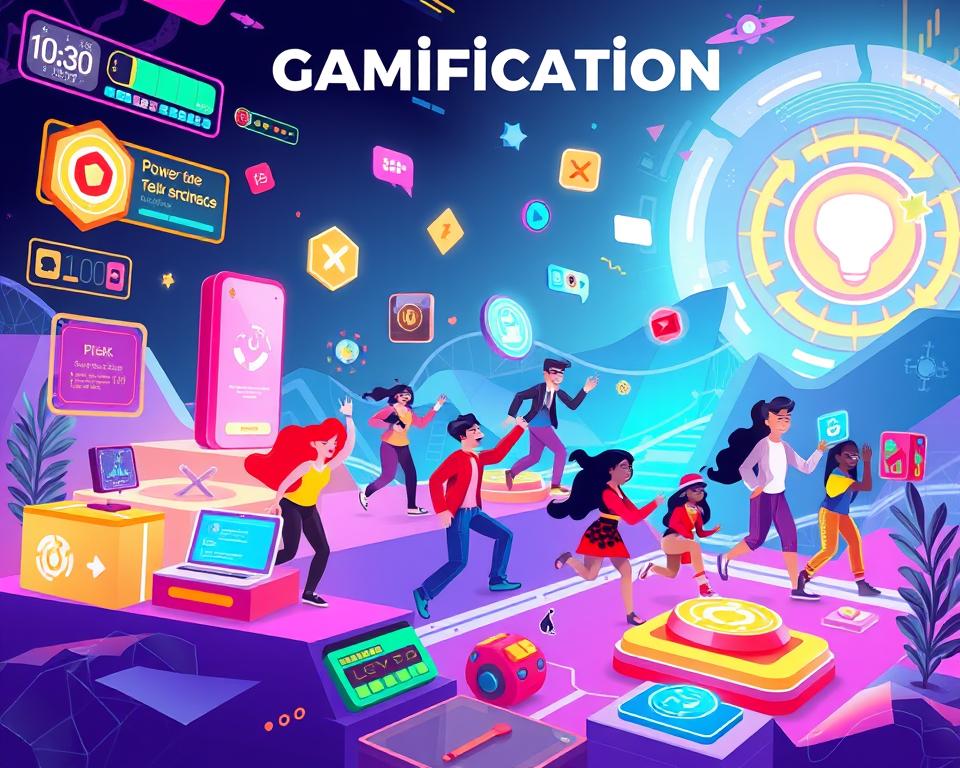Keeping users engaged is key for app success. High retention rates show users value the app. This leads to a loyal user base. Understanding app retention helps developers create effective strategies.
Developers can use many strategies to keep users. These tactics improve the app experience. This makes users more likely to stay, boosting retention rates.
Table of Contents
Key Takeaways
- Improving app retention rates is essential for the success of any mobile application
- Effective app retention strategies can increase user engagement
- Understanding the fundamentals of app retention is crucial for creating a solid foundation for app retention strategies
- Developers can leverage various app retention strategies to reduce uninstalls
- Implementing app retention strategies can lead to a positive user experience and increased user engagement
- App retention strategies can help boost user engagement and reduce uninstalls
- Developers should focus on creating a loyal user base through effective app retention strategies
Understanding App Retention Fundamentals
App retention rate is key for mobile app developers. It shows how many users keep using an app over time. Knowing this helps find ways to keep users engaged. Key metrics like daily and monthly active users give insights into how users behave.
To boost app retention, it’s important to know what affects it. Issues like a bad user experience, not enough engagement, and technical problems can lead to users uninstalling. Fixing these can make users happier and less likely to leave.
Defining App Retention Rate
App retention rate is the percentage of users who come back to an app within a set time. This time frame is usually 30 days, but it can change based on the app’s goals and audience.
Key Metrics That Matter
Important metrics for app retention include:
- Daily active users (DAU)
- Monthly active users (MAU)
- Stickiness (the ratio of DAU to MAU)
- Session length and frequency
Common Causes of App Uninstalls
Common reasons for app uninstalls are:
- Poor user experience
- Lack of engagement
- Technical issues
- Too many ads or notifications
By understanding these reasons and using key metrics, developers can make their apps more engaging. This leads to higher retention rates and fewer uninstalls.
The Critical First Week: Making a Lasting Impression
The first week after downloading an app is key for user experience and keeping users. Users form their first thoughts of the app in this time. A good onboarding and engaging content are vital for a positive start and keeping users coming back.
Research shows that engagement in the first week is a big sign of long-term use. Apps that keep users in the first week tend to keep them longer. To do this, developers should aim for a smooth user experience, easy navigation, and interesting content.
Some important ways to boost first week engagement include:
- Make the onboarding process simple to start using the app quickly
- Give users content and features that meet their needs and hopes
- Offer personalized experiences and tips to make users happier
By focusing on user experience and first week engagement, app developers can keep users longer and make their app more successful. A positive and engaging start can lead to long-term success and a loyal user base.
Optimizing Your App’s Onboarding Experience
The onboarding process is key to a good user experience. It sets the stage for a positive relationship with your app. A good onboarding process should be easy to follow, fun, and teach users about the app’s features.
To make the onboarding better, focus on making the user registration smooth. Create welcome sequences that show off the app’s best parts. Use progressive onboarding to introduce new features slowly.
Streamlining the onboarding process boosts user engagement and keeps them coming back. Make the sign-up easy and clear. Welcome sequences help users see the app’s value, leading to more use over time.
- Keep the sign-up simple and short.
- Give clear, easy-to-follow instructions.
- Offer interactive tutorials or guides.
- Use progressive onboarding to introduce new features slowly.
By following these tips, you can make your onboarding process engaging and effective. This sets your app up for success in the long run.
Performance Optimization Strategies
Improving app performance is key to keeping users happy and coming back. By focusing on performance optimization, developers make apps that work well and are easy to use. This means making code better, cutting down on delays, and saving battery life.
To get there, developers use several methods, including:
- Optimizing images and graphics to reduce file size
- Minimizing the use of heavy animations and effects
- Implementing caching mechanisms to reduce data loading times
- Using efficient data storage and retrieval methods
These steps help a lot in boosting app performance and making users happier. It’s also important to keep checking and testing the app. This ensures it stays fast and reliable over time.
Creating Engaging Push Notification Campaigns
Push notifications are great for getting users back into an app and keeping them interested. It’s key to send them at the right time, make them personal, and check how well they work. By using push notifications wisely, developers can get users to come back, try new things, and stay involved.
When making notification campaigns, think about these important points:
- Timing: Send notifications when it’s best to get users back and not too much.
- Personalization: Make messages fit each user’s likes, actions, and who they are.
- Measurement: Keep an eye on how well campaigns do to get better and send better notifications.
Adding these to your push notification plan can make your campaigns more engaging. This helps keep users coming back and loyal. Just make sure not to send too many or the wrong kind of notifications. This way, users stay interested in your app.
How to Improve App Retention Rate & Reduce Uninstalls Through User Experience
Improving app retention rates and reducing uninstalls starts with user experience. A well-designed app is easy to use, looks good, and works well. This makes users happy and keeps them coming back.
Developers should focus on user-centered design. This means making apps that users need and enjoy. It builds loyalty and keeps users engaged.
Here are some ways to boost user experience:
- Make navigation easy and workflows smooth
- Use clear and simple messages
- Keep branding and design consistent
A great app design also creates an emotional bond with users. This can happen through personalized content, rewards, and sharing features.
By focusing on user experience and app design, developers can make apps that are fun and useful. This leads to more users staying and fewer uninstalls.
Implementing Effective In-App Communication
Effective in-app communication is key to building trust and enhancing user experience. By adding in-app communication tools, developers can tackle user concerns and gather insights. This shows they care about user satisfaction. In-app communication helps developers get user feedback and respond quickly, which boosts app retention.
Chat Support Integration
Chat support is a crucial part of in-app communication. It lets users contact support teams right in the app. This cuts down on negative reviews and boosts user happiness. With chat support, developers can help users fast and fix problems quickly.
Feedback Collection Methods
Collecting feedback is vital for in-app communication. Developers can use surveys, polls, and ratings to get user input. This feedback helps spot areas for improvement and guides data-driven decisions to better the app.
Response Time Optimization
Optimizing response times is key for good in-app communication. Developers should aim to answer user queries fast, ideally in a few hours. Quick responses show they value user satisfaction and help keep users engaged.
Leveraging Data Analytics for Retention
Data analytics is key to understanding how users behave and finding the best retention strategies. It helps developers see how users interact with the app. They can find areas to improve and check if their strategies work.
Using data analytics for retention has many benefits. Here are a few:
- Identifying trends and patterns in user behavior
- Measuring the impact of different retention strategies
- Informing data-driven decision-making
By using data analytics to guide their retention strategies, developers can make the app more personal and fun. This leads to more users staying and being loyal.
Building Loyalty Through Gamification
Gamification is a great way to build user loyalty and get people more involved. It makes using an app fun and competitive. This creates a deep experience that keeps users coming back. To make it work, you need to know how gamification works and how to use it right.
A good reward system is key for keeping users loyal. You can give out rewards, badges, or rankings for reaching goals or doing tasks. For instance, a fitness app might give badges for daily steps or workouts.
Another important part is making it social. Letting users share their progress or compete with friends builds a community. You can use leaderboards, social buttons, or multiplayer games. This way, gamification and social features boost user loyalty and keep users engaged for a long time.
Some top ways to use gamification for loyalty are:
- Make reward systems that are real and reachable
- Create social features that bring people together
- Use data to see how users act and improve the game
By using these methods and the power of gamification, developers can build lasting bonds with their users. This leads to strong user loyalty and keeps users coming back.
Technical Optimization for Better Retention
Technical optimization is key for a smooth app experience. Regular app updates boost user satisfaction and keep them coming back. By focusing on technical optimization, developers can avoid issues like crashes and slow loading.
Some important parts of technical optimization are:
- Bug fixes and performance enhancements
- Optimizing battery consumption and storage space
- Ensuring compatibility with different devices and operating systems
By prioritizing technical optimization and updating regularly, developers can make users happier. This leads to more people staying with the app, making for a better experience for everyone.
Personalizing User Experience at Scale
Personalization is key to keeping users engaged and coming back. By using user segmentation, developers can make experiences fit each user’s likes and actions. This makes apps more relevant and enjoyable, building a stronger bond with users. For more on keeping users, check out mobile app retention guides.
Some ways to make user experiences better include:
- Using personalization like custom notifications and content suggestions
- Segmenting users based on their actions and preferences with user segmentation
- Letting users change things like font sizes and colors
These methods help make user experiences more engaging and personal. Adding behavioral targeting can also help. It analyzes how users act to send them content and alerts that fit their interests.
Personalization is vital in app development. It lets developers craft experiences that meet each user’s needs and wants. By using user segmentation and personalization, developers can boost user engagement, keep them coming back, and make them happier.
Maintaining App Performance Over Time
To keep an app successful, it’s key to focus on app maintenance and check its performance often. This means watching important metrics, finding ways to get better, and making updates to keep things running smoothly. This way, developers can fix problems, meet new user needs, and keep up with tech changes, leading to better long-term performance.
Good app maintenance includes keeping an eye on things, making updates, and tweaking the app. This helps avoid crashes, slow loading, and battery issues. By focusing on app maintenance, developers can make sure their app stays up to par and offers a great experience. For tips on keeping users engaged, check out this blog post on app retention strategies.
Some important ways to keep long-term performance up include:
- Updating the app often to fix bugs and boost performance
- Watching user feedback and analytics to spot areas for betterment
- Optimizing the app’s code and resources to cut down battery use and speed up loading
By using these methods and making app maintenance a priority, developers can keep their app running well over time. This leads to happier users and better long-term performance.
Creating Value Through Regular Updates
Regular updates are key to keeping users happy and loyal. By adding new features, improving existing ones, and fixing bugs, developers show they care about the app’s growth. Mobile app marketing focuses on updates to keep users coming back.
Feature releases are a big part of updates. Careful planning makes sure updates are liked and useful. This includes beta testing programs to get feedback and spot problems before the big launch.
Here are some tips for making updates valuable:
- Plan feature releases to match what users want and expect
- Tell users about updates clearly
- Use beta testing to get feedback and find issues
By focusing on updates and new features, developers can make users happy and keep them engaged for a long time.
Measuring and Monitoring Success
It’s key to measure success to see how well retention strategies work. By using analytics tools, developers can understand user behavior. They can also see how updates affect the app.
Some important metrics to watch include:
- Retention rate
- Engagement metrics, such as time spent in-app and screens viewed
- Conversion rates, such as in-app purchases or completed tutorials
Looking at metrics helps improve retention strategies. Regularly checking and analyzing data helps developers spot trends. This way, they can make smart choices to boost their app’s performance.
Analytics tools help developers measure the success of their strategies. This approach lets them fine-tune their efforts. It helps them reach their retention goals more effectively.
By focusing on measuring success and analyzing metrics, developers can build a strong retention strategy. This strategy drives growth and keeps users engaged for the long haul.
Addressing Common Retention Challenges
Developers often face common challenges when trying to improve app retention rates. Ensuring a smooth user experience is key. This can be affected by storage space, battery consumption, and crashes. To tackle these issues, developers need to use effective troubleshooting strategies.
Some major problems that can hurt app retention include:
- Storage space issues: making sure the app doesn’t crash by using storage wisely
- Battery consumption problems: keeping the app from draining the battery too fast
- Crash prevention strategies: testing and debugging to reduce app crashes
By tackling these common challenges and using good troubleshooting methods, developers can boost app retention. This leads to happier users, more positive reviews, and a higher retention rate.
Conclusion: Building Long-Term User Relationships
Creating a great app retention strategy is about building lasting bonds with users. It starts with understanding what keeps users coming back. This includes making the first experience smooth, using data to improve, and always adding new features.
Think of your app as a living thing that grows with your users. Keep it fresh with updates, make it personal, and talk to your users. This way, they’ll feel important and more likely to stay with your app. The goal is to build a community of fans who help your app grow.



















